

![]()
HERDING DOGS OF WESTERN EUROPE
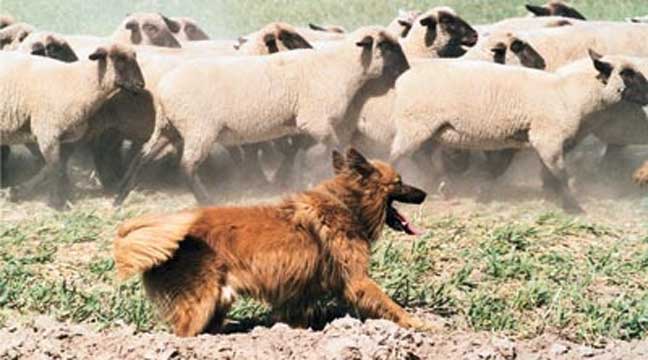
An Altdeutsher Fuchs Arbeitshund (Old German Fox working dog).
(Photo courtesy of the Arbeitsgemeinschaft zur Zucht Altdeutsher Hütehunde
(AAH-Association for Breeding the Old German Shepherd Dog)
http://www.altdeutschehuetehunde.de.)
THE HERDING DOGS OF GERMANY
Germany no longer has any large predators, and agriculture plays a very small role in the German economy (1.6 % of the German GDP). Raising sheep is a small percentage of that. Most sheep in Germany today are raised for meat. There is still some transhumance taking place today in the German Alps. There were no indigenous livestock guardian breeds in Germany, but often the herding dogs were multiple purpose for herding, farm dog, drover's dog, and guardian. Two breeds that come to mind in this capacity are the Rottweiler and the Doberman, but they are large breeds and therefore will not be covered in this particular article.
Alpine Shepherd Dog or Alpenhütehunde
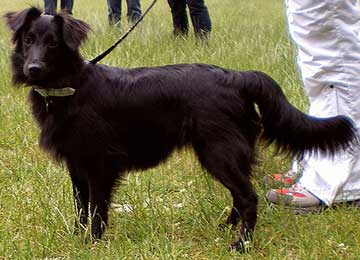
A black Alpine Shepherd
(All photos of the Alpine Shepherd Dog
courtesy of Alpenhütehunde Club Deutschland
reprinted with permission from
Christiane Rasmanns, President of the Club.
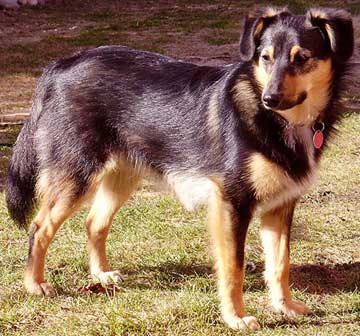
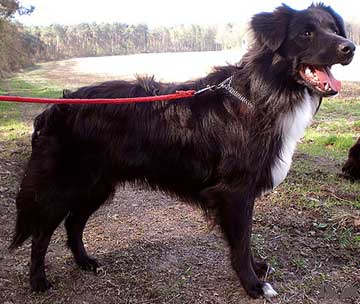 Left, a black and tan Alpine Shepherd.
Left, a black and tan Alpine Shepherd.
Right, a black and white Alpine Shepherd.
This small to medium-sized herding breed from the German Alps shares a name with a large guardian breed, so information is confusing, particularly with regard to history. There is, however, an Alpine Shepherd Club or Alpenhütehunde Club Deutschland which does include information on history; but, as with other breeds we have seen, attempts have been made to give this breed an ancient history, probably more fictitious than factual. Some trace the breed's origins to Phoenician Lebanon and claim that its appearance has not changed significantly since that day. Credit for its spread is often given to the Romans. More factually, according to the Alpine Shepherd Club, the dogs brought by the Romans likely "mixed with native races [to] create this new breed" or rather, its ancestors. As the need for herding dogs diminished, not just in the Alps but in the world, the Alpine Shepherd Dog nearly went extinct. It was brought back from the brink by being recognized for show, sports, service, and as a pet, and a breeding program that included the infusion of Sheltie genes was started. It is unlikely that there are any Alpine Shepherd Dogs being used today for serious herding, but, as is true with many herding breeds, there is interest in testing dogs for herding instincts, and participating in herding activities. If anyone knows of any being used for actual herding in the Alps, I would be happy to stand corrected.
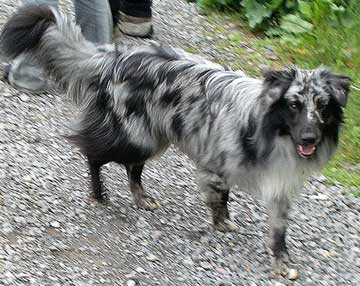
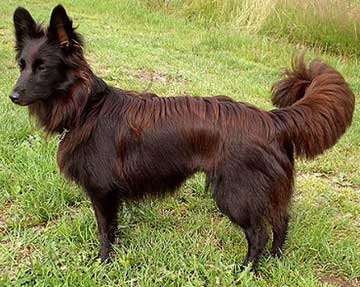 Left, a blue merle Alpine Shepherd.
Left, a blue merle Alpine Shepherd.
Right, a mahogony Alpine Shepherd with prick ears.
The breed is smaller than a Border Collie, more like a Sheltie in size or somewhere in between a Border Collie and a Sheltie. It comes in four colors: black, mahogany (which appears to be black with a reddish cast but is really a very dark brown), blond (tan or recessive yellow), and blue merle, all with white "collie markings" and sometimes tan (tricolor or tanpoint). It has a long tail and can have either erect or semi-erect ears. It in fact looks like a smaller version of other Alpine sheepdogs.
Below, a blond Alpine Shepherd with prick ears.
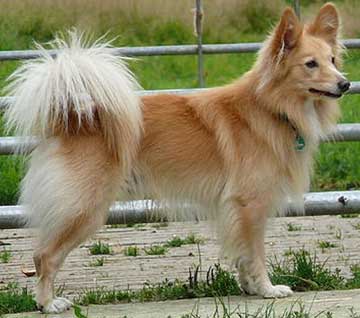
Old German Shepherd Dog or Altdeutsche Schaeferhund or Hütehunde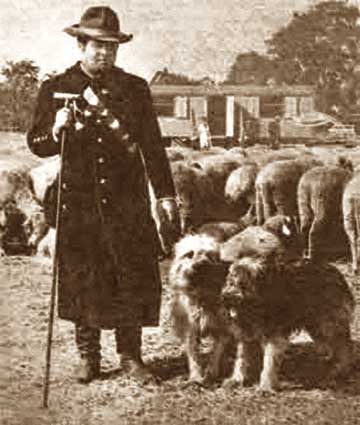
An old photo of a German shepherd with two Schafpudels.
(Photo in the public domain.)
Altdeutsche Schaeferhund (ADS) were the primary working sheep- and cattle-dogs of Germany. They varied considerably in type. Dogs from among many different strains were used by Capt. Max von Stephanitz and others to develop the modern German Shepherd Dog (GSD), bred primarily for police and service work, and as a companion and show dog. However, the ADS, similarly to the old working collies in Britain, was bred solely for use in herding and therefore its appearance remained diverse.
The ADS traces its roots to the early Middle Ages when transhumant pastoralism developed in Germany and dogs were used to drive sheep, pigs and cows short and long distances, and for herd and flock protection. Farms were isolated, and local dogs developed for particular uses. As flocks and herds moved, shepherds, herdsmen and drovers met, and dogs often interbred. In looks, even today, they vary considerably, even within types. They come in all colors, and sometimes there are white "collie markings", at least on the chest and legs. Coat type is also very variable. Rough coated, smooth-coated, bearded, curly, and even somewhat wire-haired have all been described. In addition, some dogs are naturally bobtailed, and these are termed Stumper.
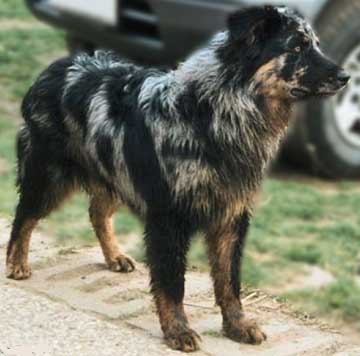
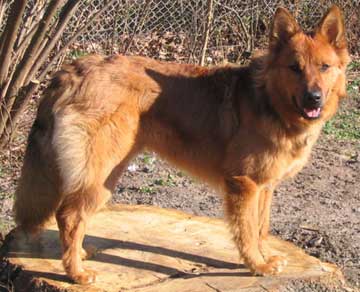 Left, a young Tiger (blue merle). (Photo by Susanne Zander of AAH and reprinted with permission.)
Left, a young Tiger (blue merle). (Photo by Susanne Zander of AAH and reprinted with permission.)
A Harzer Fuchs (fox). (Photo from Wikipedia by Björn Doppke, and licensed under the Creative Commons Attribution-Share Alike 3.0 Unported license.)
There are names for each type, but they are not separate breeds. Names are more descriptive of color, coat type, or region of origin. Each type evolved in a particular area of Germany as a landrace. "Tiger" is used to describe merle colored dogs, mostly distributed in Bavaria in the south of Germany. This includes the Bavarian Alps, and the Tiger may, in fact, be related to the Cane di Oropa from the Italian Alps, or at least it is a similar type. Fuchs or fox indicates a reddish coat which is actually sable, with or without a black mask, and saddle-pattern is also possible. A particular type of fuchs is the Harzer Fuchs, a cattle-dog that traditionally herded the red cattle in the Hartz Mountains of northern Germany.
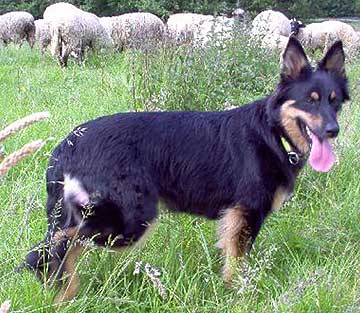
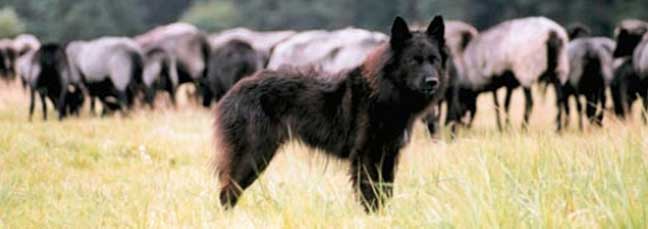 Left, a Gelbbacke or "yellow jaw".(Photo from Wikipedia by Ann-Christin Hellmuth, licensed under the Creative Commons Attribution-Share Alike 3.0 Unported license.)
Left, a Gelbbacke or "yellow jaw".(Photo from Wikipedia by Ann-Christin Hellmuth, licensed under the Creative Commons Attribution-Share Alike 3.0 Unported license.)
Right, a Schwarzer with a sheep flock. (Photo by Susanne Zander of AAH and reprinted with permission.)
The Gelbbacke or "yellow jaw" is an East German variety of black-and-tan dog. There are two types of Altdeutsche Schwarzer (Old German Black) that differ considerably. The Central or East German Black is about 22 inches. That from South Germany is a larger dog, a powerful worker that was also used as a flock guardian. Both are all-black and rough-coated. Both types utilize grip.
The Westerwälder Kuhhund (cowdog) was first mentioned in the old German common laws of 1465. It has a natural heeling ability, nipping low at the heels of cattle, and was used for taking large groups of cattle from village to village and keeping them together on unfenced pastures. It is a medium-sized dog, 18 to 22 inches at the shoulder, and most commonly comes in a medium-rough, hard coat, somewhat curly, reddish (sable with or without a black mask), and often with a saddle pattern. It is used today primarily to herd dairy cows and protect the people working with them by keeping the cattle off.
Below, a Westerwälder Kuhund herding sheep. (Original photo from Susanne Zander of AAH and reprinted with permission.)
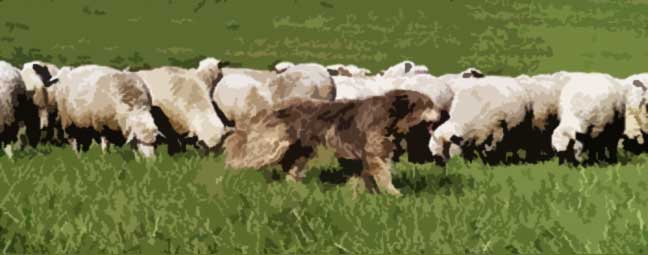
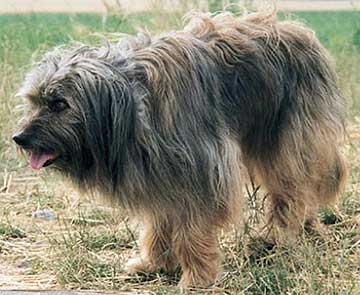
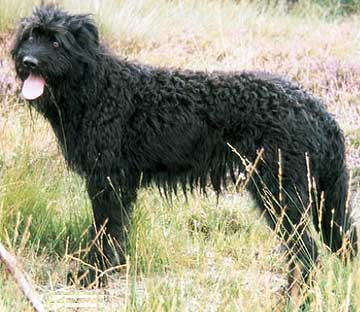 A Schafpudel today. (Photo by Susanne Zander of AAH and reprinted with permission.)
A Schafpudel today. (Photo by Susanne Zander of AAH and reprinted with permission.)
A Strobel, also a bearded type, this one with a very curly coat. (Photo by Susanne Zander of AAH and reprinted with permission.)
A bearded type of ADS is the Schafpudel, found mostly in Friesland, Mecklenburg, and western Pomerania, but some today are owned as pets and these, unfortunately, are bred with heavier and longer coats. The Strobel, also bearded, is typical of the dogs used in Baden Wüerttemberg and Bavaria. Rorem mentions the all-white Pomeranian Sheepdog and the Hütespitz, two types that may be extinct today. The Hütespitz also haled from Pomerania, a historic area on the south shore of the Baltic Sea that spans the northern boundary between Germany and Poland, and may be related to the spitz-type dogs of Scandinavia. The word spitz is German and means "pointed", which may refer to the erect, pointed ears of the spitz breeds. Hütespitz means "pointed hat". Many more now extinct German herding types are mentioned in Stephanitz.
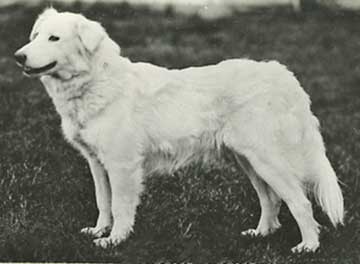
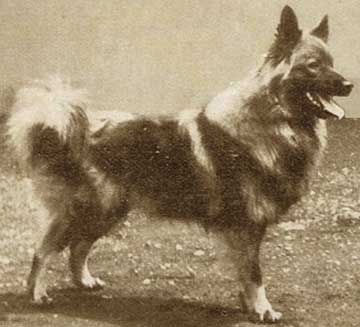 Left, A Pomeranian Sheepdog, now extinct. (Photo 1939, in the Public Domain.)
Left, A Pomeranian Sheepdog, now extinct. (Photo 1939, in the Public Domain.)
A 1939 photo of a Hütespitz, also a now-extinct German herding dog from Pomerania. (Photo in the Public Domain.)
Today there is a registry, Die Arbeitsgemeinschaft zur Zucht Altdeutscher Hütehunde (AAH--Association for Breeding the Old German Shepherd Dog), formed in 1989, which, like the Welsh Sheepdog Society, aims to preserve and promote the ADS in its various forms as working stockdogs. In order to be registered, dogs must show ability to work on sheep or cattle. The organization also seems proud of the fact that none of the types under its guardianship are registered with the FCI. These types can be found today throughout Germany still working flocks and herds. The AAH holds sheepdog trials in Germany, where dogs are expected to demonstrate their ability to keep the sheep in a tight bunch, moving them forward in a controlled manner in a large open field and along a road with no fencing, guarding the flanks to keep sheep from straying into planted crops. The shepherd walks before the flock, and gives short instructions to the dog. The dogs appear disconnected until they have to move in to turn a stray or motivate the flock to move. However, their mere presence keeps the flock in line. This mimics how sheep are managed in many parts of Germany today, where they are grazed for a while in one unfenced pasture, or contained by portable net fencing, and then gathered and moved to the next pasture, and so on. The shepherd remains with the flock.
Below, a Schafpudel, clipped for the summer, herding sheep.
(Photo by Susanne Zander of AAH and reprinted with permission.)
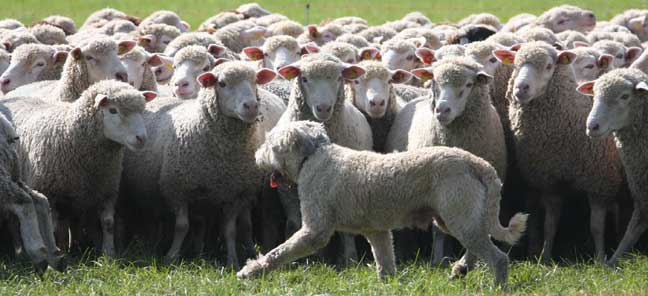
Resources:
Alpine Shepherd Club (http://www.acd-ev.de).
Arbeitsgemeinschaft zur Zucht Altdeutsher Hütehunde (AAH-Association for Breeding the Old German Shepherd Dog) (http://www.altdeutschehuetehunde.de).
Rorem, Linda. "The Old German Shepherd Dog in America" (http://www.herdingontheweb.com/oldgermanshepherdinUS.htm).
Von Stephanitz, Capt. Max. The German Shepherd Dog, originally published ca. 1918 in German; 8th edition published in German in 1932; English edition of 8th edition published 1947, published by Verein für deutsche Schäferhunde.
Wikipedia (http://en.wikipedia.org), various pages.
Special thanks to Alberto Bertelli.
Copyright © 2013 by Carole L. Presberg
Return to
![]()
BORDER COLLIE COUSINS
THE OTHER WEB PAGES WE MAINTAIN
These web pages are copyright ©2013
and maintained by webmeistress Carole Presberg
with technical help from webwizard David Presberg
ALL RIGHTS RESERVED
If you are interested in using ANY material on this website, you MUST first ask for permission.